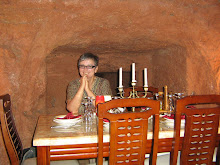
This morning I got caught in a downpour as I went for my walk. I set off to find the Marsaxlokk remnant wetland I heard about in the Wildlife and Habitats course that I am doing in Mosta. It is in a corner at the opposite end of the bay from where my flat is and I wasn't aware of it until it was mentioned as one of the important remaining areas of saline marshland. It is difficult to access as it is fenced off from the beach and also from the road but the fence is down in one spot and there is a clear path through, probably where fishermen have accessed the beach. It is somewhat degraded with rubbish but it was good to see it in the rain and it still supports several species of dune plants.
The downpour also helped me to understand some more about the rainfall patterns in Malta. When it rains here, mostly in the winter months, the downpours are short and heavy and the run-off pours down the valleys to the sea bays. Marsaxlokk is one of the seafront villages at the bottom of a valley and now that it has been built up, the rainwater pours down the roads and floods briefly on the front. In some other areas such as Msida, this is a problem and often traffic is prevented from getting through for a few hours until the water clears. It doesn't seem to be more than a temporary inconvenience in Marsaxlokk as the water pours across the front and into the sea without too many obstructions. But I can see how in the past, the saline marshland would have been extensive and an important part of the ecology of the area.
This post is about walking around Dingli cliffs. The picture at the top is of Verdala castle taken as we were walking towards Buskett gardens. As I discovered on my cultural tour yesterday with the Department of Arts and Culture, Verdala was of course built by the knights as a residential fortification and is now the winter residence of the Prime Minister. The knights also planted the forests around to support their hunting and although the British later removed a lot of the trees to make way for agriculture and the orchards that still cover much of the valley, this is still the most heavily wooded area of Malta.
The walk from the lovely village of Dingli to Busketto gardens and then along to the Dingli cliffs was another in the programme organised by Malta Ramblers Association but this time it was mid-week. The meeting place was St Mary's parish church in Dingli village so I had to catch the 81 bus from Valletta and just got there on time. There were fewer people than on the weekend walk through Wied Garnaw but still over 60 walkers set off with an enthusiastic German guide to lead us. We walked out of the village past the mandatory village statue of a local celebrity - this time a beautifully worked bronze of a poet, Charles Ebejer, sitting reading in a chair.
We walked along country lanes past a well maintained and signed local park towards Busketto. The guide pointed out the ancient cart ruts that can be made out across a slight valley on the slope of a rocky cliff near to an old quarry. There was some debate about going through the forest as this would add about half an hour onto the timing for the walk and the evenings are drawing in now but most people wanted to walk through and I was glad that we did. The forest here is lovely with lots of native trees such as Holm Oaks and Mediterranean pine as well as groves of fruit trees such as oranges.
Our time in the forest meant that we were walking along the cliffs just before sunset. The sea was flat calm and it was stunning. Just enough cloud to redden the horizon and the dramatic fall of the cliff face. We came to a small chapel on the edge of the cliff with about ten minutes before the sun disappeared and we all found rocks or the verandah of the chapel to sit and watch. At this point, the cliff edge drops down to some terraced fields that are beautifully tended and I spotted on the rocks at the top some of the plants I have been learning about in the course I am doing. It was a magic moment.
It was after 5.00pm when we got back to Dingli and I was now pushed for time to get to Mosta for 5.30 for the evening class on insects, arachnids and crustaceans. So as the walking group was rounding things off, I asked if anyone was driving past Mosta and sure enough someone was going to visit their daughter who lived there. I arrived at class just as everyone was going in to the lecture room and the exhilaration of the walk carried me through a rather dry couple of hours on insect classification!

No comments:
Post a Comment